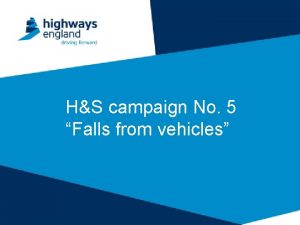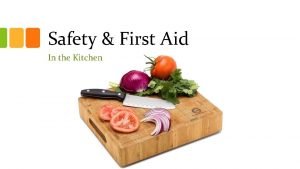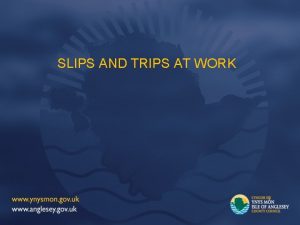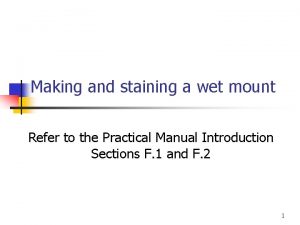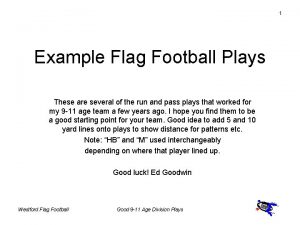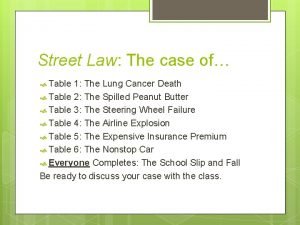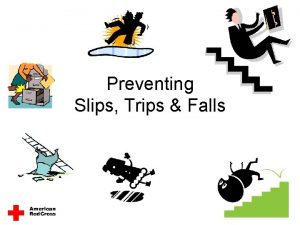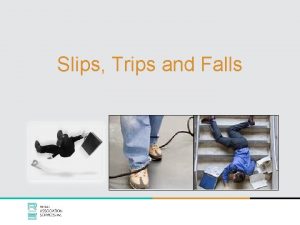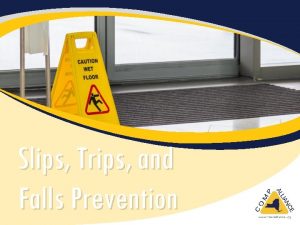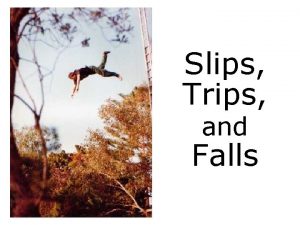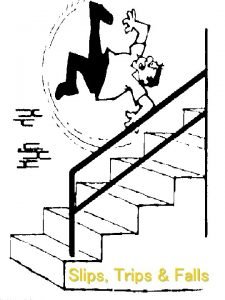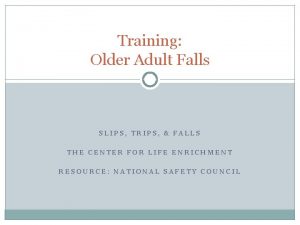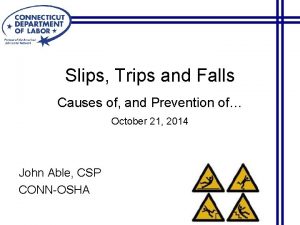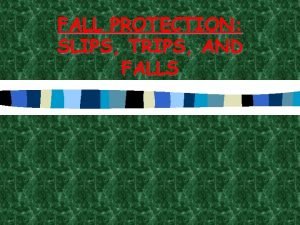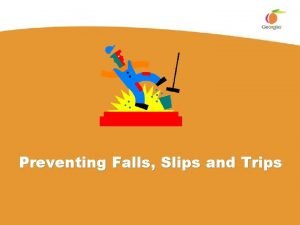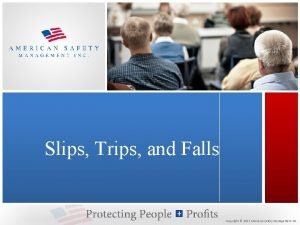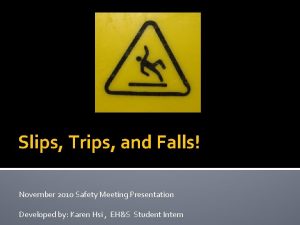SLIPS TRIPS FALLS Slips trips and falls are























- Slides: 23

SLIPS, TRIPS & FALLS

Slips, trips and falls are the most important cause of major injuries in shipyards and boatyards.

Injury Cases - % of Injuries Data provided by the Shipbuilder's Council of America Quarterly Illness and Injury Survey for 2006

Types of Falls There are two types of Falls: Elevated Falls Same-Level Falls

Elevated Falls vs. Same Level Falls Elevated Less Frequent More Severe Involves Striking an object during a fall Over 60% are from less than 10 ft. Same Level More Frequent Less Severe Usually involves slips or trips

Slips Causes: Slippery surfaces Wearing the wrong footwear Two types of slips during normal walking: As the heel of the forward foot contacts the walking surface, the foot slips forward, and the person falls backward. The rear foot slips backward, and the person falls.

Slips Cont… Friction is the force that allows someone to walk without slipping. Traction is the adhesive force between the walking surface and the sole of the shoe The higher the friction, the better the traction: Low traction: icy, wet, oily, or waxed surfaces Higher traction: dry concrete or other dry surfaces Use of slip resistant footwear can reduce slips and the resultant falls and injuries.

Trips Cause: Sudden stop caused by foot striking an object, throwing the upper body forward. Examples: Un-level walking surfaces, even as minor a difference as 3/8 inches A slight difference in a stair can cause a fall up the stairs

Trips Cont… Step and fall Front foot lands lower than expected (i. e. stepping off a curb) Normally falls forward Turing an ankle results from stepping on an uneven surface

Prevention of Slips, Trips, & Falls Good housekeeping Keep areas free of obstacles Use yellow lines to delineate walking and working areas Provide adequate lighting

OSHA 1910. 22(a)Housekeeping (1) All places of employment, passageways, storerooms, and service rooms shall be kept clean and orderly and in a sanitary condition. (2) The floor of every workroom shall be maintained in a clean and, so far as possible, a dry condition. Where wet processes are used, drainage shall be maintained, and false floors, platforms, mats or other dry standing places should be provided where practicable.

OSHA Subpart F 1915. 91(a) Housekeeping Good housekeeping conditions shall be maintained a all times. Adequate aisle and passageways shall be maintained in all work areas. All staging platforms, ramps, stairways, walkways, aisles and passageways on vessels or drydocks shall be kept clear of all tools, materials, and equipment except that which is in use, and all debris such as welding rod tips, bolts, nuts, and similar material. Hoses and electric conductors shall be elevated over or placed under the walkway or working surfaces or covered by adequate crossover planks.

EXAMPLES OF POOR HOUSEKEEPING

Behaviors that Lead to Falls Walking to fast Running Rapid changes in direction Horseplay

Behaviors that Lead to Slips, Trips, & Falls Cont… Distractions Not watching where one is going Carrying materials which obstruct view Wearing sunglasses in low-light areas

Failure to Use Handrails

Falls from Ladders may be fixed or portable. Straight-extension-or step-ladders may be manufactured from wood, metal, plastic, or fiberglass. Ladders can be light-, medium-, heavy-, or extra-heavy-duty (Extraheavy–duty ladders are required in commercial and industrial applications). Ladders can be two feet high (stepstools), 18 feet for extra-heavy-duty step-ladders, and 40 feet or longer for extension-type ladders.

Ladders Cont… Ladders should be inspected before use: Check for cracks, loose rungs, slivers, and sharp edges. Never paint ladders, as the paint can hide potentially dangerous conditions. Wooden ladders can be coated with linseed oil or an oil-based wood preservative to keep them from drying out and cracking. Allow ladders to dry thoroughly before using them or the rungs will be slippery.

Falls on Stairs Stairwells should be well-lighted Need sturdy handrails on both sides. Persons using the stairwell should have one hand free to be able to use the handrail. All steps should have the same rise and depth, with visible edges. Stairs must be kept free of grease, oil and obstacles which could cause slips and trips. Avoid carrying heavy or bulky objects which obscure your vision and/or require the use of both hands.

Fixed Ladders Fixed ladders are mounted on buildings, bins and other tall structures which require workers to climb to high levels to perform some functions. Workers climbing or descending a fixed ladder should have both hands free. Small tools can be carried in a tool belt; other tools and materials should be raised by rope and pulleys or some other mechanical system.

Fall Protection Devices Workers at high elevations, such as ladders, platforms, or catwalks, should be protected from falling by some kind of fall protection device. This can be a protective cage, lifeline, lanyard, safety harness; there are numerous devices on the market.

Shoes and Boots According to the National Safety Council, there are 110, 000 injuries each year to the feet and toes of the United States workers, representing 19 percent of all disabling work injuries. The most important protection is to wear the proper footwear for your work and environment. The soles and heels should be slip-resistant The toe of the should resist crushing injuries The should support the ankle All boots/shoes should meet the ANSI rating

Recommendations Established policies and practices can be implemented to significantly reduce the number of injuries and deaths due to slips, trips and falls. Owners, managers and supervisors must make a commitment to prevent accidental slips, trips, and falls. Regular inspections of working and walking areas should be conducted to identify any hazards. All workers should wear proper footwear for their work and environment. All slips, trips and falls, with or without injury, should be reported and investigated.
 Slips trips and falls presentation
Slips trips and falls presentation Hse slips trips and falls video
Hse slips trips and falls video Mikael ferm
Mikael ferm First aid for slips and falls in the kitchen
First aid for slips and falls in the kitchen Sternal and costal slips of diaphragm
Sternal and costal slips of diaphragm Detention slips
Detention slips Work slips
Work slips Cover slip drawing
Cover slip drawing Freudian slips
Freudian slips Freudian slips
Freudian slips Freudian slips
Freudian slips Intrazonal vs interzonal
Intrazonal vs interzonal Motion pictures cone of experience
Motion pictures cone of experience School trips to chateau du molay
School trips to chateau du molay Article 27 of trips agreement
Article 27 of trips agreement Trips right
Trips right What is trips
What is trips Sixteen year old carrie is babysitting
Sixteen year old carrie is babysitting New amsterdam vacation
New amsterdam vacation External-external trips
External-external trips Dealskins
Dealskins Trips everywhere 2
Trips everywhere 2 Adventure-trips in portsmouth
Adventure-trips in portsmouth Trips everywhere
Trips everywhere

